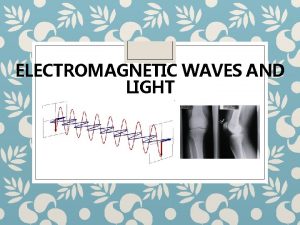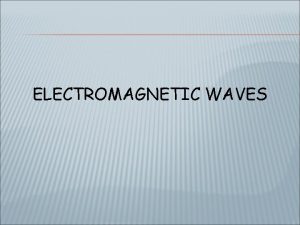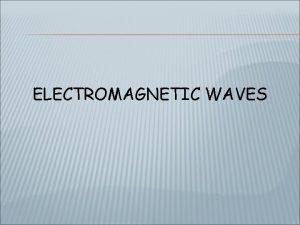WAVES REVIEW ELECTROMAGNETIC WAVES INTRODUCTION Radio Waves Microwaves






- Slides: 6

WAVES REVIEW & ELECTROMAGNETIC WAVES INTRODUCTION Radio Waves Microwaves Infrared Visible Light (Red, Orange, Yellow, Green, Blue, Indigo & Violet) Ultraviolet X-Rays Gamma Rays

REVIEW FOR ALL WAVES � � � ELECTROMAGNETIC WAVES � All Waves are caused by a vibration. Every vibration has a frequency, f, and a period, T. � Electromagnetic waves are caused by a vibrating electric charge (usually an electron). Every electromagnetic wave has a frequency, f, and a period, T. � The frequency of an electromagnetic wave is the number of times the electric charge vibrates in one second (hz). The frequency of any wave is the number of times it vibrates in one second (hz). WHAT CAUSES A WAVE?

REVIEW FOR ALL WAVES � � The matter that waves travel through is called the medium. Some waves, called mechanical waves, require a medium to travel. Other waves don’t. Sound is an example of a mechanical wave. Sound travels by vibrating the matter it is travelling through (its medium). Sound cannot travel through a vacuum. ELECTROMAGNETIC WAVES � � Electromagnetic waves can travel through a medium. Electromagnetic waves do not require a medium to travel. Light is an example of an electromagnetic wave. Light can travel through a vacuum (no matter). WHAT DOES A WAVE TRAVEL THROUGH?

REVIEW FOR SOUND � � Sound is a longitudinal wave. This means the vibration that produces the sound travels along the same direction as the wave moves. ELECTROMAGNETIC WAVES � � Electromagnetic (EM) waves are transverse waves. This means the vibration that produces the EM wave travels perpendicular to the direction the wave travels. Direction of Travel Vibration WHAT IS THE TYPE OF WAVE?

WAVELENGTH & AMPLITUDE FOR AN ELECTROMAGNETIC WAVE wavelength, λ Equilibrium Position Amplitude, A The wavelength, λ, is the distance between the peaks (crests) of an electromagnetic wave. The amplitude, A, is the maximum displacement from the equilibrium position for an electromagnetic wave.

REVIEW FOR SOUND � � � Sound travels at a constant speed in the same medium. This constant speed is called the speed of sound. In air (20 o. C @ sea level) the speed of sound is 340 -m/s or 760 -mph. ELECTROMAGNETIC WAVES � � WAVE SPEED Electromagnetic (EM) waves travel at a constant speed in the same medium. This constant speed is called the speed of light, c. The speed of light in a vacuum is 3 X 108 -m/s (300, 000 -m/s) or 186, 000 -mi/sec. NOTHING travels faster than the speed of light!!!!
 Starting to wavelength lyrics
Starting to wavelength lyrics Differences between mechanical and electromagnetic waves
Differences between mechanical and electromagnetic waves Light is an electromagnetic wave true or false
Light is an electromagnetic wave true or false Mechanical waves and electromagnetic waves similarities
Mechanical waves and electromagnetic waves similarities Mechanical and electromagnetic waves similarities
Mechanical and electromagnetic waves similarities Difference between matter waves and electromagnetic waves
Difference between matter waves and electromagnetic waves Electromagnetic waves vs mechanical waves
Electromagnetic waves vs mechanical waves











